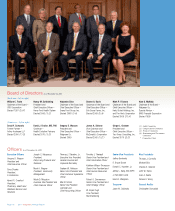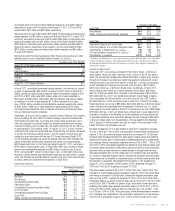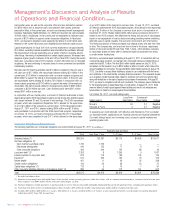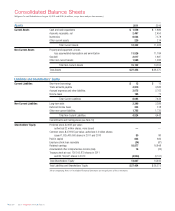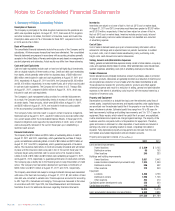Walgreens 2011 Annual Report Download - page 20
Download and view the complete annual report
Please find page 20 of the 2011 Walgreens annual report below. You can navigate through the pages in the report by either clicking on the pages listed below, or by using the keyword search tool below to find specific information within the annual report.
Management’s Discussion and Analysis of Results
of Operations and Financial Condition
Express Scripts. If a contract renewal is not reached, beginning next calendar year,
Express Scripts’ network would no longer include Walgreens more than 7,700
pharmacies nationwide. Express Scripts, in its capacity as a pharmacy benefits
manager, processed approximately 88 million prescriptions filled by Walgreens in
fiscal 2011, representing approximately $5.3 billion of our sales. This development
is expected to adversely affect our net sales, net income and cash flows in fiscal
2012. We intend to moderate the impact of this development on our consolidated
financial results by seeking to retain business from Express Scripts’ clients (consistent
with their contractual obligations to Express Scripts), expand our business with other
payers and customers, and implement cost saving initiatives. While the Company
cannot predict what percentage of business it may retain or regain from entities
and groups that were Express Scripts’ clients in fiscal 2011 in any particular future
period, over time, we believe employers and others will want plans with Walgreens
in the network. With respect to fiscal 2012, the Company has plans in place designed
to offset approximately 50 percent of any reduction in gross profit resulting from a
loss of up to 75 percent of the business from Express Scripts’ clients, primarily through
reductions in cost of goods sold and selling, general and administrative expenses.
There can be no assurance, however, that for the portion of fiscal 2012 beginning
January 1, 2012, the Company will retain any particular level of business from Express
Scripts’ clients, and if the Company were to lose more than 75 percent of such business
it is uncertain whether the Company would be able to offset as much as 50 percent of
the reduction in gross profit resulting from the marginal loss of such business above
75 percent. See “Cautionary Note Regarding Forward-Looking Statements.” In July
2011, Medco Health Solutions, Inc., another large pharmacy benefit manager, and
Express Scripts announced an agreement to merge, completion of which is subject
to regulatory and other conditions. If the merger is successfully completed, the
Company may face additional reimbursement pressure or potential loss of business.
Total front-end sales have grown due to sales gains in existing stores, acquired
stores and new store openings. Front-end sales have increased in the non-
prescription drugs, convenience and fresh foods, personal care, beer and wine
and beauty categories.
To support our growth, we are investing in prime locations, technology and
customer service initiatives. We are focused on retail organic growth; however,
consideration is given to retail and other acquisitions that provide unique opportu-
nities and fit our business objectives, such as our acquisitions of drugstore.com,
which enhanced our online presence, and Duane Reade, which consisted of 258
Duane Reade stores located in the New York City metropolitan area, as well as
the corporate office and two distribution centers.
Restructuring
On October 30, 2008, we announced a series of strategic initiatives, approved by
the Board of Directors, to enhance shareholder value. One of these initiatives was
a program known as “Rewiring for Growth,” which was designed to reduce cost
and improve productivity through strategic sourcing of indirect spend, reducing
corporate overhead and work throughout our stores, rationalization of inventory
categories, and transforming community pharmacy. We completed these initiatives
in the fourth quarter of fiscal 2011.
We have recorded the following pre-tax charges associated with our Rewiring
for Growth program in the Consolidated Statements of Earnings (In millions):
Twelve Months Ended August 31, 2011 2010 2009
Severance and other benefits $ 5 $ 16 $ 74
Project cancellation settlements — — 7
Inventory charges — 19 63
Restructuring expense 5 35 144
Consulting 37 50 76
Restructuring and restructuring-related costs $ 42 $ 85 $ 220
Cost of sales $ — $ 19 $ 63
Selling, general and administrative expenses 42 66 157
$ 42 $ 85 $ 220
Severance and other benefits included the charges associated with employees
who were separated from the Company. In the current fiscal year, 72 employees
have been separated from the Company. Since inception, a total of 962 employees
have been separated from the Company as a result of these initiatives.
Inventory charges relate to on-hand inventory that has been reduced from cost to a
selling price below cost. In addition, as a part of our restructuring efforts, we sold an
The following discussion and analysis of our financial condition and results of
operations should be read together with the financial statements and the related
notes included elsewhere herein. This discussion contains forward-looking
statements that involve risks and uncertainties. Our actual results may differ
materially from those discussed in forward-looking statements. Factors that
might cause a difference include, but are not limited to, those discussed under
“Cautionary Note Regarding Forward-Looking Statements” below and in Item 1A
(Risk Factors) in our Annual Report on Form 10-K.
Introduction
Walgreens is principally a retail drugstore chain that sells prescription and non-
prescription drugs and general merchandise. General merchandise includes,
among other things, household items, convenience and fresh foods, personal
care, beauty care, photofinishing and candy. Customers can have prescriptions
filled in retail pharmacies as well as through the mail, and customers may also
place orders by telephone and online. At August 31, 2011, we operated
8,210 locations in 50 states, the District of Columbia, Guam and Puerto Rico.
Total locations do not include 357 Take Care Clinics that are operated primarily
within other Walgreens locations.
Number of Locations
Location Type 2011 2010 2009
Drugstores 7,761 7,562 6,997
Worksite Health and Wellness Centers 355 367 377
Infusion and Respiratory Services Facilities 83 101 105
Specialty Pharmacies 9 14 15
Mail Service Facilities 2 2 2
Total 8,210 8,046 7,496
The drugstore industry is highly competitive. In addition to other drugstore chains,
independent drugstores and mail order prescription providers, we compete with
various other retailers including grocery stores, convenience stores, mass merchants
and dollar stores.
The Company’s sales, gross profit margin and gross profit dollars are impacted
by, among other things, both the percentage of prescriptions that we fill that are
generic and the rate at which new generic versions are introduced to the market.
In general, generic versions of drugs generate lower total sales dollars per pre-
scription, but higher gross profit margins and gross profit dollars, as compared
with patent-protected brand name drugs. The positive impact on gross profit margins
and gross profit dollars has been significant in the first several months after
a generic version of a drug is first allowed to compete with the branded version,
which is generally referred to as a “generic conversion.” In any given year, the
number of major brand name drugs that undergo a conversion from branded to
generic status can increase or decrease, which can have a significant impact on
our sales, gross profit margins and gross profit dollars. And, because any number
of factors outside of the Company’s control or ability to foresee can affect timing
for a generic conversion, we face substantial uncertainty in predicting when such
conversions will occur and what effect they will have on particular future periods.
The long-term outlook for prescription utilization is strong due in part to the aging
population, the increasing utilization of generic drugs, the continued development
of innovative drugs that improve quality of life and control health care costs, and
the expansion of health care insurance coverage under the Patient Protection and
Affordable Care Act signed into law in 2010 (the ACA). The ACA seeks to reduce
federal spending by altering the Medicaid reimbursement formula (AMP) for
multi-source drugs, and when implemented, is expected to reduce Medicaid
reimbursements. State Medicaid programs are also expected to continue to seek
reductions in reimbursements independent of AMP. In addition, the Company
continuously faces reimbursement pressure from pharmacy benefit management
(PBM) companies, health maintenance organizations, managed care organizations
and other commercial third party payers, and the Company’s agreements with
these payers are regularly subject to expiration, termination or renegotiation.
On June 21, 2011, Walgreens announced that contract renewal negotiations
with pharmacy benefit manager Express Scripts, Inc. (Express Scripts) had been
unsuccessful, and as a result the Company was planning not to be part of the
Express Scripts pharmacy provider network as of January 1, 2012. Since then,
there has been no substantive progress in the contract renewal negotiations with
Page 18 2011 Walgreens Annual Report










